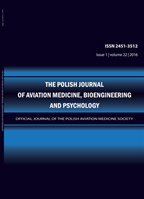2020, Volume 26, Issue 2
STABLE INTRAOPERATIVE PULSE OXIMETRY VALUES DO NOT PROTECT AGAINST A DECREASE IN REGIONAL CEREBRAL OXYGEN SATURATION IN PATIENTS UNDERGOING PRIMARY HIP ARTHROPLASTY. A PILOT STUDY
DARIUSZ TOMASZEWSKI1, MARIUSZ BAŁKOTA2, ZBIGNIEW RYBICKI2, MARCIN WAŚKO3
-------------------------------------------------------------------------------------------------
1Department of Anesthesiology and Intensive Therapy, Military Institute of Aviation Medicine
2Department of Anesthesiology and Intensive Therapy, Military Institute of Medicine
3Department of Radiological Diagnostics and Medical Imaging, The Medical Center for Postgraduate Education in Warsaw
Autor korenspondencyjny: DARIUSZ TOMASZEWSKI; Department of Anesthesiology and Intensive Therapy, Military Institute of Aviation Medicine; email: dariusz.tomaszewski@wiml.waw.pl
Full text
Streszczenie
Background and Study objective: Continuous perioperative monitoring of blood oxygen saturation via pulse oximetry is an established standard of care. The incidence of postoperative cognitive dysfunction (POCD) in orthopedic patients is higher when compared to any other group of hospitalized patients. Although its etiology remains unclear, factors such as thromboembolic complications may play a role. Thromboembolic material, including that released from the surgery site, enters the bloodstream and then travels to the brain. The decrease in blood flow in the involved cerebral vessels may decrease cerebral oxygen saturation. Considering this, we decided to determine if the regional cerebral saturation monitored by near-infrared spectroscopy corresponds with readings of blood oxygen saturation monitored by pulse oximetry in patients who underwent primary total hip arthroplasty.
Methods: A total of 20 patients scheduled for elective total hip arthroplasty were enrolled in the study. All orthopedic procedures were performed under spinal anesthesia and intravenous sedation. Monitoring of regional cerebral oxygen saturation (rSO2) was carried out from the time of the initiation of spinal anesthesia until the end of the surgery, using the near-infrared spectroscopy method. In all, 15 patients were analyzed.
Results and Conclusions: We found the following: (1) rSO2 values decreased continuously over the surgery, and (2) rSO2 value changes were not related to mean arterial pressure variations or to hemoglobin saturation as analyzed by pulse oximetry.
Słowa kluczowe
blood pulse oximetry, regional cerebral oxygen saturation, primary hip arthroplasty
